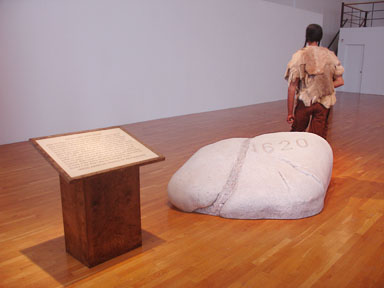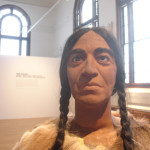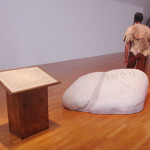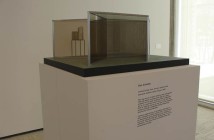Almost every American remembers learning about the Pilgrims, Squanto, and the first Thanksgiving in elementary school. We learned about the treacherous sail of the Mayflower, the writing of the Mayflower Compact, and the historic landing at Plymouth Rock. This story is etched into the psyche of almost every American child, and it is this myth’s privileged place in the collective unconscious of this country that Sam Durant addresses with his Scenes from the Pilgrim Story: Myths, Massacres, and Monuments at MassArt. The exhibit retells the origin myth of the United States with an eye toward making clear that this moment, not unlike many other episodes from this country’s history, is filled with murder, conquest, and greed.
The exhibit features two sculptures that utilize wax figures acquired by the artist from the Plymouth National Wax Museum, which closed in 2004. Durant also exhibits a video documentary retelling the story of the Pilgrims, the footage made up entirely of photographs taken of the museum’s wax figure exhibits before the PNWM closed. Upon entering the gallery one first comes across Subject/Position/Object/
Placement (Pilgrim Monuments; Massosoit, Metacomet, and Plymouth Rock), 2006. This three-part sculpture recreates a plaque found in Post Office Square in Plymouth that describes the brutal murder of Wampanoag leader Metacomet and the selling of his family into slavery. Durant places a life size replica of Plymouth Rock next to this recreated plaque and then a wax figure of Metacomet with his back turned to the viewer. In Plymouth these monuments are spatially separated around the town. In the gallery, they are juxtaposed and compressed. You cannot read the plaque without seeing Plymouth Rock out of the corner of your eye, and are thus made to contemplate two different histories at once, one of cruelty and murder, the other idealized and accepted.
Moving to face the wax Metacomet, one experiences a kind of shock. The pseudo-lifelike figure’s left eye is slightly off, giving him a lazy eye. The overall effect of this waxwork of the great Native American leader is comical and anti-climatic. His eyes appear glazed, his expression without personality. Pilgrims and Indians, Planting and Reaping, Learning and Teaching, 2006, also features wax figures that provoke a similar response. A large double-sided diorama on which the figures are placed rotates slowly clockwise to show two different scenes. One scene shows the English speaking Native American Squanto helping the Pilgrims fertilize their crop (one Pilgrim also has a lazy eye). The other scene shows Capt. Standish killing Pecksuot in a fight. Both are based closely on actual dioramas exhibited at the PNWM (Durant provides color photocopies of postcards from the museum showing each of the original dioramas). Again one is struck immediately by how funny and ridiculous these wax figures actually are. Their faces appear frozen, or in a kind of shock, like they were caught off guard as someone took their snapshot. Their stoned expressions signify a kind of death more than they are able to actually bring history to life.
Durant’s re-contextualizing of these pathetic wax figures in the gallery creates a situation where one’s laugh can break through historical repression and open the door to a more accurate, or at least less idealized, realm. By replicating or recycling Plymouth Rock, the Metacomet plaque, and the museum wax figures Durant adopts the vocabulary of the tourist trap PNWM to recreate a historical recreation. This strategy of repetition or doubling insists on history’s material archive (of which the wax figures are a part) in order to reveal its own inconsistencies, biases, and mythologizing. Significantly, the time of the exhibit overlaps with both Thanksgiving and the date the Pilgrims landed at Plymouth (December 11th), thus restaging the events of 1620 some 386 years later.
While watching the diorama in the middle of the gallery rotate clockwise ever so slowly, we experience history repeated in an endless circle. The two scenes reveal in turn the actual relationship of the Pilgrims to the Native Americans, a dialectic of dependence and exploitation. The origin of the United States’ brand of freedom is revealed to be an origin grounded in conquest and death. Through the never-ending repetition of the spinning diorama one cannot help but draw a link from the conquest depicted and its resulting genocide to the present day political situation, characterized as it is by imperialism and war. While the psychic and political reasons for our current compulsion to repeat, this death drive, are allusive and confusing, Durant makes sure that its original moment is crystallized and unmistakable.
Links:
Massachusetts College of Art
Sam Durant
"Scenes from the Pilgrim Story: Myths, Massacres, and Monuments" is on view at the Stephen D. Paine Gallery at MassArt until December 22nd.
All images are courtesy of the artist and MassArt Galleries.







